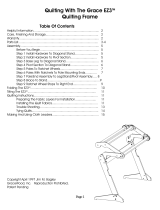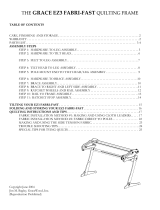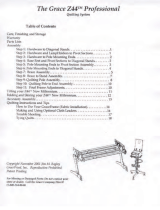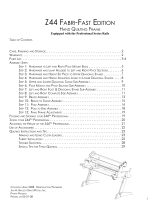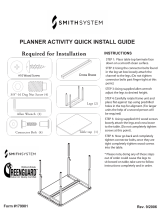Page is loading ...

1
Quilting With The Grace NM-EZ3
TM
Quilting Frame
Table Of Contents
Helpful Information...........................................................................x
Care, Finishing And Storage............................................................ x
Warranty........................................................................................... x
Parts List........................................................................................... x
Assembly........................................................................................... 1
Before You Begin.................................................................. 1
Step 1 Install Hardware To Diagonal Stand........................ 1
Step 2 Install Hardware To Pivot Section............................. 1
Step 3 Install Hardware To Mounting Ends......................... 2
Step 4 Base Feet To Diagonal Stand.................................... 2
Step 5 Pivot Sections to Diagonal......................................... 2
Step 6 Ratchet Wheels to Poles........................................... 3
Step 7 Assembling the Frame in Different Sizes................... 3
Step 8 Ratchet Stops and Poles with Wheels to Mounting Ends 4
Step 9 Brace Assembly........................................................ 5
Step 10 Pole/End Assembly To Leg/Stand/Pivot Assembly 5
Folding The EZ3
TM
............................................................................ 6
Tilting The EZ3
TM
.............................................................................. 7
Quilting Instructions......................................................................... 7
Preparing The Fabric Layers For Installation.....................7
Installing The Quilt
Fabrics..................................................7
Trouble Shooting....................................................................9
Tying Quilts...........................................................................10
Making And Using Cloth Leaders.....................................................10
Copyright November 2000 Jim M. Bagley
GraceWood, Inc. Reproduction Prohibited,
Patent Pending

2
Care of your NM-EZ3
TM
The frame may be sealed and/or stained with an application of tung oil which will help preserve
the wood and will help to prevent warping. To add a certain color to your frame, you may use a
Danish Oil finish. We recommend the Deft
TM
or Watco
TM
brands. Test stain on an inconspicuous
place. Many different finishes and/or stains may be suitable for sealing and beautifying your frame.
You may want to consult your local paint retailer for finishes which will apply easily and dry hard-not
oily.
Tips
--Store frame in a dry place-preferably with poles and braces in vertical position if not assembled.
--Do not carry the frame by the quilting poles.
--Do not drop the frame or let it twist out of square.
Warranty
Warranty card must be filled out and sent to: GraceWood, Inc. EZ3
TM
Warranty
P. O. Box 27823
Salt Lake City, Utah 84127
GraceWood, Inc. will replace or repair, at our choosing, any part of the Grace NMEZ3
TM
Quilting Frame, which
may be shown to be defective. Warranty expires one year after the date of purchase and does not cover parts
damaged through misuse, improper storage, improper assembly, loss, natural events and willful or accidental
destruction. Defective parts may be returned only with a valid RMA# or Returned Merchandise Authorization
Number which may be obtained by calling GraceWood, Inc. at (801) 485-6688. Warranty registration card
must be returned within 30 days of purchase for warranty to be valid.
For correspondence concerning your NMEZ3
TM
, write to:
The Grace Company
P.O. Box 27823
Salt Lake City, UT 84127
For shipping of materials to the Grace Company address package (postage prepaid) to: The Grace Company,
801 West Layton Avenue, SLC, UT 84104 Materials may be returned only with a valid RMA# or Returned
Merchandise Authorization Number which may be obtained by calling GraceWood, Inc. at (801) 485-6688.
For technical support, call (801) 485-6688. All calls will be returned. Please report any errors in these
instructions or make constructive comments to the following:
FAX - (801) 485-4388 - E-mail - [email protected] - http://www.graceframe.com
About the Grace Quilting Frame
The Grace Quilting System has been developed over the past decade with several original design innovations.
Due to feed back from many of the thousands of quilters who have purchased and do use the GraceFrame
TM
,
we have been able to make a frame that will truly enhance the entire process of hand quilting from beginning
to end. If you have any suggestions that will help us to improve our product or service, please write to The
Grace Company.

3

4

5
Quilting With the Grace NM-EZ3
TM
56/96
Quilting Frame
Before You Begin
< Using the parts list as a reference, take the parts out of the box and make sure that you have
them all. (If there is something missing or broken, contact The Grace Company. We will
promptly ship any needed item.)
Tools Needed
< To assemble the frame you will need a few common tools. Once the frame is assembled, no
tools will be needed for the use of the frame.
1. One 1/2" wrench
2. One 7/16" wrench (A combination or socket wrench will also work.)
3. Phillips Head Screw Driver
Note: To help you distinguish wood parts, all Left Side parts are marked with an “L” grooved
into the wood on the inside
of the part.
Step 1: Hardware to Diagonal Stands
Parts Needed: Right and Left Diagonal Stands
6 - 5/16" x 2" Carriage Bolts
6 - Jamb Nuts
6 - 1/4" Smaller Flat Washers
< Note direction carriage bolt goes through the part.
< Tighten nuts on carriage bolt to pull the square part of the
bolt into the wood until the bolt is seated into the wood
part.
Step 2: Hardware to Pivot Sections
Parts Needed: Right and Left Pivot Sections
2 - 5/16" x 2" Carriage Bolts
2 - Jamb Nuts
2 - 1/4" Smaller Flat Washers
< Note direction of carriage bolts to Pivot Sections. (See
Below)
< Position carriage bolts through pivot sections as shown
in drawing. Tighten jamb nuts over end of carriage bolts until the square
part of the carriage bolt is drawn and seated into the wood.
Right SideLeft Side

6
Step 3: Hardware to Pole Mounting Ends
Parts Needed: Right and Left Mounting Ends
4 - 5/16" x 2" Carriage Bolts
4 - 1/4" Smaller Flat Washers
4 - Jamb Nuts
< Note direction carriage bolt goes through the part.
< Tighten nuts on carriage bolt to pull the square part of the
bolt into the wood until the bolt is seated into the wood
part.
Step 4: Base Feet to Diagonal Stands
Parts Needed: Right and Left Base Feet
2 - Diagonal Stands (w/ Hardware Installed)
2 - Wing Nuts
2 - Nylon Lock Nuts
4 - 5/16"Large Flat Washers
< As shown in drawing (right), position carriage bolt ends through
holes in base legs.
< For ease of tightening, thread flat washers and lock nuts onto the
bottom carriage bolts first.
< **Nylon side of nylon lock nuts faces out when threading
onto the Bolt end.**
< **Leave all nylon lock nuts loose enough to slide the joint.**
< Next, thread the washers and wing nuts on the top carriage bolts.
Step 5: Pivot Sections to Diagonal Stands
Parts Needed: Right and Left Pivot Sections (w/ Hardware Installed)
2 - Wing Nuts
2 - Nylon Lock Nuts
4 - 5/16" Large Flat Washers
< Align the carriage bolts that are already installed on
the pivot sections and the diagonal stands through the
holes as shown on the pictures (right).
< Notice that the flat washer and wing nut are threaded
onto the end of the lower carriage bolt toward the
outside of the frame. The washer and nylon lock nut
are loosely threaded onto the upper carriage bolt
toward the inside of the frame.
Step 6: Ratchet Wheels to Poles

7
Parts Needed: 3 - Ratchet Wheels
6 - Screws
3 - Quilting Poles
Note: The terms pole and rail are used interchangeably.
< Identify the three (longer) poles with bolts
coming out of both ends, and line them up on
the floor so that the holes drilled through the
poles are all on the left. Place the ratchet
wheels on the end of the pole opposite the
hole (see left). Designate which rail will be
the front pole.
< Position the quilting poles through the
ratchets as shown in the drawing.
< Note the direction of the ratchet wheel teeth:
Be sure they are going the right direction.
(Use the bottom two diagrams on page 4 as a
guide. Holding the ratchet stops in proper
position, they should fit right in to the wheel
when the teeth are facing the correct
direction).
< Fasten the wheels to
the poles using the
small silver grabber
screws and a Phillips
head screw driver.
To properly secure, it
will be necessary to
screw at a slight
angle.
< It is recommended
that you use two
screws to fasten
each
wheel.
Step 7: Assembling the frame in different sizes
Parts Available: 3 - Connector Sleeves
6 - Connecting Bolts
6 - Cap Nuts
1 - Smaller Alan Wrench (Black)
1 - Larger Alan Wrench (Silver)
< The NMEZ3
TM
can be set up with the Crib size
(56") work area, or Queen size (96") work area.
< To set up the frame in Crib size, use the three
longer rails (that have ratchet wheels) by
themselves.
< To set the frame up in Queen size, combine the
two size rails by inserting the longer rail (end

8
opposite the cog wheel) into the shorter rail (end without the bolt--
see right ).
< Connect the two rails using the metal connector sleeve.
Line up the holes in the sleeve with the holes in the raise.
Fasten the sleeve to the rails by putting a connecter bolt
though the smaller sleeve hole. Then place a cap nut
through the larger sleeve hole and thread it onto the
connector bolt. Completely tighten using the two Alan
wrenches provided. The black one is used with the bolt and
the silver one with the cap nut.
< Repeat this process for the remaining two rails.
Step 8: Ratchet Stops and Poles with
Wheels to Mounting Ends
Parts Needed 6 - 1/4" Smaller Flat Washers
6 - Plastic Washers
6 - Nylon Lock Nuts
3 - Ratchet Wheel Stops
3 - 1/4" x 1 1/2"
Hex Head Bolts
< Place a plastic washer on each
rail end (see middle right).
< Position rail bolts (on ratchet
wheel end) through the three
holes of the Rright Pole
Mounting End as shown in
drawing. Thread the 1/4" Flat
Washers and the 5/16" Nylon
Lock Nuts onto the ends of
these bolts.
< **All Lock Nuts must be left
loose enough that the poles
will roll freely.
< Position the rail bolts on the
other end through all the holes of the
Left Mounting End. Thread the 1/4"
Flat Washers and the 5/16" Nylon
Lock Nuts onto the ends of these
bolts
< Position the Ratchet Stops as
shown (right). Using fingers--
not a tool!-- gently tighten the
1/4" X 1 1/2" Hex Head Bolts
through the Stops and into the
metal inserts. Only tighten so
that the Hex Bolt Head is about

9
1/4" away from the Stop. Finger Tighten Only!
< Set aside this assembly until Step10.
Step 9: Brace Assembly
Parts Needed: 2 - Braces
2 - 5/16" x 1 1/2" Hex Bolts
2 - 5/16" Large Flat Washers
2 - 1/4" x 3 1/2" Hex Bolts
2 - 1/4" Smaller Flat Washers
2 - Rectangle Nuts
2 - Diagonal Stand Assembly
< Match the brace size with the pole size previously
assembled. (See top left)
< Connect the two brace pieces together using the
5/16" x 1 1/2" hex bolts and washers as pictured.
< **Important: Be sure the silver T-nuts (imbedded
in the brace) face outside so they are clearly
visible. (See middle left).**
< Insert the bolts and washers as pictured. Only finger
tighten these bolts at this time.
< Align the keyed end of the brace into the Diagonal Stand as
shown in picture (bottom left). Insert 1/4" X 3 1/2" Hex Head Bolt
through a 1/4" flat washer (smaller) and into the Diagonal Stand.
Place the Rectangle Nut into the slot so the hole lines up with the
bolt. Tighten the bolt into the Rectangle Nut until the
thbolt is
pulled all the way into the slot. This should be a good
solid joint. (Repeat for other side).
Step
10:
Poles/Ends Assembly to
Leg/Stand/Pivot Assembly
Parts Needed: 1 - Pole/End Assembly
2 - Leg/Stand/Pivot Assembly
4 - 5/16" Large Flat Washers
2 - Wing Nuts
2 - Lock Nuts

10
< On the Leg/Stand/Pivot Assembly,
slide the braces outward the widest
they will go in their current setting.
< Fasten the Pole/End Assembly to the
Leg/Stand/Pivot Assembly by placing
the four carriage bolts through Pivot
sections on each side as pictured.
Do this one side at a time. **You will
need to stretch the last end out
slightly to get carriage bolt through
it.**
< With both assemblies together, stand
at the front of the frame. Thread a
lock nut on the carriage bolt closest
to the front, and a wing nut on the
one further from the front. (See
right).**Do not overtighten Lock
Nuts! The washer must be able to
spin freely.
Your Frame is Now Assembled!!
Folding the NM-EZ3
TM
< Frame must not be tilted when it is to be folded.
(See Tilting the NMEZ3
TM
in next section.)
< The folding feature will not affect the quilt in
progress.
< Some practice may be required to fold the quilting
frame in 20 seconds.
< Folded frame is about 6-1/2" wide.
< Follow the steps in order, without variation.
< Reverse
steps to unfold.
< You can use
the WingGrip Tool
to loosen and
tighten your wing
nuts!
Step 6: Lift Entire Frame From the Brace Until Legs Drop at the
Joint.
Step 7: Frame Will Rotate Forward and Down.
Step 8: Gently Lay Frame Flat

11
Tilting the NM-EZ3
TM
Quilting on the NM-EZ3
TM
Preparing the Fabric Layers For Installation
<Make sure that each layer of fabric is the correct size and has straight edges and square corners.
The short time and small effort that you spend measuring and squaring will result in much time saved
later in the quilting process.
<If the lining or backing has a seam running down the middle, then be sure to cut the selvedge off at
the seam and press the seam open through its entire length.
<Bonded batting is strongly recommended.
Installing the Quilt Fabric Layers
1. Backing Fabric
<The first fabric that will be applied to the quilting frame is the Backing. The Backing is also known as
the lining fabric. This piece of fabric will be the under side of the finished quilt. It is recommended
that this piece of fabric be larger than the top, on all four sides, especially if your top is a pieced top.
(A pieced top may stretch out and become larger than the backing if you do not make this
allowance). The Backing fabric can be one continuous piece of fabric or can be made by sewing
fabric together.
2. Piecing the Backing fabric
<Many quilts have back fabrics that are not one
continuous piece of fabric and are pieced together
using two fabric pieces with a seam down the
middle or three fabric pieces with two seams having
been sewn. Cut the selvedge off before you piece
the back fabric together. The selvedge is woven
more tightly than the rest of the fabric and wont

have the same give as the rest of the
fabric. This may cause the seam to be too
tight. Use a slightly larger, looser machine
stitch than normal in sewing/piecing the
lengths of the back fabric together. You
also can sew your back fabrics together
using crosswise piecing.
3. Front Pole- Backing fabric
<Mark the center of Backing Fabric with a
pin or pencil mark.
<Tack the center mark to the center of the
Front Pole. (The Backing Fabric is put on
with the wrong side of the Fabric up and
visible.)
<Lay the Fabric naturally and evenly
along the straight edge of the Pole. Do
not stretch the Fabric from side to side.
Tack the corners of the Fabric to the Pole.
<Add a few more Tacks to hold the material
on the Pole
4. Middle Pole- Opposite end of Backing
Fabric
<Tack the other end of the Backing Fabric
to the Middle Quilting Pole, centering with
the mark as directed on the Front Pole.
<Tack the center mark to the center of the
Middle Pole. Lay the Fabric naturally and
evenly along the straight edge of the Middle
Pole. Do not stretch the Fabric. Tack the
corners of the fabric to the Pole.
<Make sure that the amount of wood showing
at the edges of the Fabric to the End Boards
is the same on all Poles.
<Securely tack the Backing Fabric along the
entire edge of the Middle Pole, using plenty
of Tacks.
<Roll the material onto the Middle Pole,
making a smooth roll. Be sure that no
wrinkles are present.
<Smooth the Quilt from the center to the
outside edges of the Pole as it is being rolled.
At this point do not roll the Fabric tightly, just
nicely smooth and even.
<Roll until there is very little slack between
the two Poles.
<*Note* Fabrics should never be tight. For
best results, use as little tension as
possible without letting the Quilt sag.
5. Batting and Quilt Top
<Lay the Quilt Top face down on the floor and line your batting directly over it. Mark the center of the

Top.
< Line up the edge of the Quilt Top/Batting to
the inside rear pole as shown.
<Tack the center the Top/Batting to the
center of the rear pole. Tack the corners.
Make sure that the Quilt Top is centered with
the Backing already installed.
<Roll the Top/Batting onto the rear pole by
rolling the rail away from the front of the
frame. Make sure it rolls smoothly.
<When you reach the end of the fabric, pull
the loose end of the Top/Batting over the
backing and line it up on the front rail.
<Completely tack the Batting and Quilt Top
moving from the center out to each corner.
<Remember to smoothly and evenly
lay the Quilt Top to the Front Pole without stretching from corner to corner during the
tacking process.
<On the rear pole, measure the wood from quilt edge to End Board. This measurement should be
equal to the Quilt Top edge to End Board measurement of the Front Pole.
<Adjust the tension to the Backing Fabric and Batting and Quilt Top Fabrics until you get the desired
tensions. DO NOT OVER TIGHTEN!
TROUBLE SHOOTING
Problem: Fabric sags on one side or in middle.
Solution: Fabric may not be cut evenly straight or the grain of the cloth may not be square. Take it
off and square it up or pull (gently) to square.
Problem: Sides of quilt have a concave edge.
Solution: The fabric was stretched along the pole. Take the fabric off and let it relax until it is not
misshapen and then re-install, without stretching it along the edge.
Problem: Batting tears or separates during the tightening of the ratchet wheels.
Solution:
The Batting was stretched and stressed. The Batting should be longer than the Quilt that
you are making and there should be no tension applied to it. Remember to use a few extra inches of
Batting and let it sag down between the two rear poles. This will stop the Batting from pulling. You
may unroll the rear pole and fix the Batting at any time during the quilting process.
Problem:
Poles are bowing in.
Solution:
The causes may be: 1. Seam down the center of the Fabrics may be sewn too tightly and
is not giving with the rest of the Fabric. If the Seam is the problem the Quilt may be ttached
sideways, 2. Fabric is not cut evenly. 3. Too much tension has been applied. 4. Fabric has been
stretched along the
Poles instead of naturally
laid along the Poles then
attached.

14
Problem: Fabric pulls/tears out at the Thumbtacks when
tension is applied.
Solution: Seat the Tack all the way in. The Head of the
Tack, not the post of the Tack, should hold the Fabric. Use
a Tack Hammer to seat the Tacks if your hand is not
strong enough.
Problem: Poles squeak as they roll or they do not roll freely.
Solution: The Nylon Lock Nuts are too tight. Loosen them with a 1/2" wrench about 1/2" to a full turn.
If the Quilting Frame still squeaks or is difficult to roll make sure that the frame is in good square
alignment and/or rub some Paraffin or Candle Wax on the Bolts in the ends of the Poles.
Helps for Tied Quilts:
Before installing the Quilt onto the Frame, mark both the Quilt Top and Backing in a similar
increments along the two side edges. (The sides that are not tacked onto the Poles.) While rolling
the Quilt during the tying process watch the marks. This will help you to keep an equal tension on the
Top and Backing Fabrics so you wont over tighten one or the other of your Fabrics. When rolling into
a new area of tying, allow your last row of ties to remain in the new area of tying. Also, tie your knots
tight. Do Not over roll your last row of ties over the turn in the Pole.
Making and Using Cloth Leaders
Use of cloth leaders
<This is only a suggestion for making one kind of cloth leaders. There are many ways and
ideas for making cloth leaders. Dont hesitate about trying your own ideas. Just remember that the
widest strip of fabric should be applied to the rear pole. This allows the whole quilt to come up into
the area of quilting without stopping and adjusting the quilt top to the second pole in order to finish it.
<
The best cloth selection for making cloth leaders is unbleached muslin or mattress ticking. However,
the ticking is a much more expensive selection.

15
<
Purchase: 2-2/3 Yards of Fabric (Mattress Ticking or Canvas work best).
<
Step 1. Cut the fabric as shown in illustration above.
<
Step 2. Finish the cut edges of the leaders with either a serge stitch or with a very straight 1/2" hem
allowance. Press the leader cloth with a warm iron.
<
Step 3. Draw straight, dark, solid line 1" from one edge of each of the leader cloths.
<
Step 4. Thumb tack the cloth leaders to the poles as shown on illustration below.
<
Step 5. Pin or baste your quilt fabrics to the cloth leaders. Use the dark, straight line that you
marked on your leaders in Step 2 to align your quilt fabrics with.
<
Step 6. Roll the Cloth Leaders and Quilt Fabrics up on Poles.
<
Step 7. You are now ready to begin
quilting.

/
